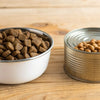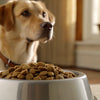Is Wet or Dry Dog Food Healthier? Exploring the Best Options for Your Furry Friend
- Houndsy
Table of Contents
- Introduction
- Understanding Dog Nutrition
- The Processing Differences: How Wet and Dry Dog Foods Are Made
- The Benefits of Wet Dog Food
- The Drawbacks of Wet Dog Food
- The Benefits of Dry Dog Food
- The Drawbacks of Dry Dog Food
- Mixing Wet and Dry Dog Food: A Balanced Approach
- Choosing the Right Dog Food for Your Pet
- Conclusion
Introduction
Did you know that nearly 60% of dog owners are unsure about whether wet or dry dog food is healthier for their pets? With so many choices available, it can be overwhelming to determine the best diet for our beloved companions. The choice between wet and dry dog food isn’t just about preference; it significantly impacts your dog’s health, hydration, and overall well-being.
At Houndsy, we understand the importance of making informed decisions for our pets. In this blog post, we will explore the key differences between wet and dry dog food, delve into their respective benefits and drawbacks, and discuss how to choose the best option for your furry friend. By the end of this article, you'll have a comprehensive understanding that helps you make the best feeding choices for your pup.
Understanding Dog Nutrition
Before diving into the debate of wet versus dry food, it's essential to grasp the basics of dog nutrition. Dogs, like humans, require a balanced diet that includes proteins, fats, carbohydrates, vitamins, and minerals. Finding the right balance in your dog's diet can enhance their energy levels, improve their coat health, and support their immune system.
Nutritional Components
- Proteins: Vital for growth and repair, proteins are essential for muscle development and overall health. High-quality dog foods will list specific protein sources, like chicken or beef, as the primary ingredient.
- Fats: Essential fatty acids support skin and coat health while providing energy. A diet that includes healthy fats, such as omega-3 and omega-6, can help maintain your dog’s shiny coat.
- Carbohydrates: Though not essential, carbohydrates provide energy and can aid in digestion. High-quality carbohydrates, like sweet potatoes or brown rice, can be beneficial.
- Vitamins and Minerals: These micronutrients support various bodily functions, including bone health, immune function, and overall vitality.
Now that we understand the key components of dog nutrition, let's explore how wet and dry dog food stacks up against each other.
The Processing Differences: How Wet and Dry Dog Foods Are Made
Understanding how dog food is processed can help shed light on their nutritional content and benefits.
Wet Dog Food Processing
Wet dog food, often found in cans or pouches, has a high moisture content, typically between 75-85%. It is produced through the following steps:
- Ingredient Preparation: Raw ingredients, including meats and vegetables, are ground and mixed with water, vitamins, and minerals.
- Cooking: The mixture is then cooked at high temperatures to both sterilize the food and enhance flavors.
- Packaging: After cooking, the food is sealed in cans or pouches to retain freshness and moisture.
Dry Dog Food Processing
Dry dog food, commonly known as kibble, contains much less moisture, usually around 5-10%. Its production involves:
- Ingredient Mixing: Ingredients are combined into a dough-like consistency.
- Extrusion: The mixture is cooked and then extruded through shapes to form kibble.
- Drying: The kibble is dried to remove moisture and ensure a longer shelf life.
The Benefits of Wet Dog Food
Wet dog food offers a variety of health benefits for your furry friend, making it an attractive option for many pet owners.
1. Higher Moisture Content
One of the most notable advantages of wet dog food is its high water content, which can be especially beneficial for dogs that do not drink enough water. Proper hydration is crucial for maintaining kidney health and preventing urinary tract issues.
2. Enhanced Palatability
Many dogs find wet food more appealing due to its strong aroma and texture. This can be particularly useful for picky eaters or dogs experiencing a reduced appetite due to illness or stress.
3. Increased Satiety
Wet food can provide a feeling of fullness due to its moisture content, which can be helpful for dogs that need to manage their weight. The high moisture content allows dogs to feel satisfied without consuming excess calories.
4. Easier to Chew
For older dogs or those with dental issues, wet food is often easier to chew and digest. Its soft texture can make mealtime more enjoyable for these pets.
The Drawbacks of Wet Dog Food
While wet dog food has many benefits, it's essential to be aware of its potential downsides.
1. Cost
Wet dog food can be more expensive than dry food, especially if you have a large breed dog or multiple pets. The cost can add up quickly if wet food comprises their primary diet.
2. Spoilage
Once opened, wet food should be refrigerated and consumed within a few days to prevent spoilage. This can pose a challenge for dogs that prefer to graze throughout the day.
3. Dental Health Concerns
Wet food does not promote chewing in the same way that dry food does. This means it may not help in preventing plaque and tartar buildup, leading to potential dental issues over time.
The Benefits of Dry Dog Food
Dry dog food is a popular choice among pet owners for several compelling reasons.
1. Convenience and Storage
Dry dog food is easy to store, measure, and serve. It doesn’t require refrigeration, making it convenient for pet owners with busy lifestyles. Additionally, kibble can be left out for dogs that prefer to graze throughout the day without the risk of spoilage.
2. Cost-Effective
Generally, dry food is more affordable than wet food, particularly when feeding larger breeds or multiple dogs. This makes it an economical choice for many pet owners.
3. Dental Health Benefits
The crunchy texture of kibble can help to scrape away plaque and tartar during chewing, contributing to better dental health. While it shouldn't replace regular dental care, dry food can aid in maintaining oral hygiene.
4. Nutrient Density
Dry dog food is typically more nutrient-dense than wet food. With lower water content, you might need to feed less volume to meet your dog's nutritional needs, which can be beneficial for weight management.
The Drawbacks of Dry Dog Food
Despite its advantages, dry dog food does have some drawbacks.
1. Lower Moisture Content
Dry food lacks moisture, which can be a disadvantage for dogs that need extra hydration. If your dog doesn't drink enough water, you might want to consider incorporating wet food into their diet.
2. Less Palatable
Some dogs may find dry food less appetizing than wet food, particularly if they are used to a wet diet. This can lead to decreased food intake in picky eaters.
3. Potential for Obesity
Kibble is calorie-dense, and without proper portion control, it can lead to weight gain. Pet owners need to be vigilant about measuring food portions to avoid overfeeding.
Mixing Wet and Dry Dog Food: A Balanced Approach
Many pet owners find that mixing wet and dry dog food offers the best of both worlds. Combining the two can enhance palatability while providing the benefits of both moisture and crunch.
Benefits of Mixing
- Improved Hydration: Adding wet food to dry kibble can increase your dog's water intake.
- Enhanced Flavor: The combination can entice picky eaters to consume their meals.
- Balanced Nutrition: Mixing allows you to provide a varied diet, which can be beneficial for overall health.
Considerations
If you choose to mix wet and dry food, be mindful of the total caloric intake to prevent overeating. Consulting with your veterinarian can help you determine the appropriate balance for your dog's specific needs.
Choosing the Right Dog Food for Your Pet
When deciding between wet and dry dog food, it's essential to consider your dog's individual needs, preferences, and lifestyle. Here are some factors to keep in mind:
- Age and Breed: Puppies, adult dogs, and seniors have different nutritional requirements. Additionally, larger breeds may require more cost-effective feeding options.
- Health Conditions: Dogs with specific health issues, such as kidney problems or dental disease, may benefit from a particular type of diet.
- Feeding Habits: Consider whether your dog prefers to graze or eat all at once. This can influence whether dry or wet food is more suitable.
- Budget: Assess your budget for dog food to ensure you're choosing an option that works for your financial situation.
Conclusion
Ultimately, whether wet or dry dog food is healthier depends on your dog’s specific needs, preferences, and lifestyle. Both types of food offer unique benefits that can contribute to your dog's overall health and happiness. By understanding the differences, you can make an informed choice that supports your canine companion's well-being.
At Houndsy, we are dedicated to enhancing the daily feeding experience for pet owners. Our flagship product, the Houndsy Kibble Dispenser, combines innovative design with ergonomic convenience, ensuring that your pet receives the perfect portion every time while complementing your home decor. Explore how our solutions can simplify your pet care routine and elevate the feeding experience for both you and your furry friend.
FAQ
1. Can I feed my dog only wet food?
While it’s possible to feed your dog a diet consisting solely of wet food, it's important to ensure that it meets their nutritional needs. Consult your veterinarian for personalized recommendations.
2. Can I combine wet and dry dog food?
Yes! Mixing wet and dry food can provide a balanced diet and improve hydration and palatability. Just be mindful of overall calorie intake.
3. Which is better for dental health—wet or dry food?
Dry food is generally better for dental health due to its crunchy texture, which can help reduce plaque buildup. However, regular dental care is still essential.
4. How do I choose the right dog food for my pet?
Consider your dog’s age, breed, health conditions, and feeding habits when selecting food. Consulting with your veterinarian can also provide valuable insights.
5. How can I ensure my dog stays hydrated?
If your dog primarily eats dry food, encourage hydration by providing plenty of fresh water and considering incorporating wet food into their diet for added moisture.












